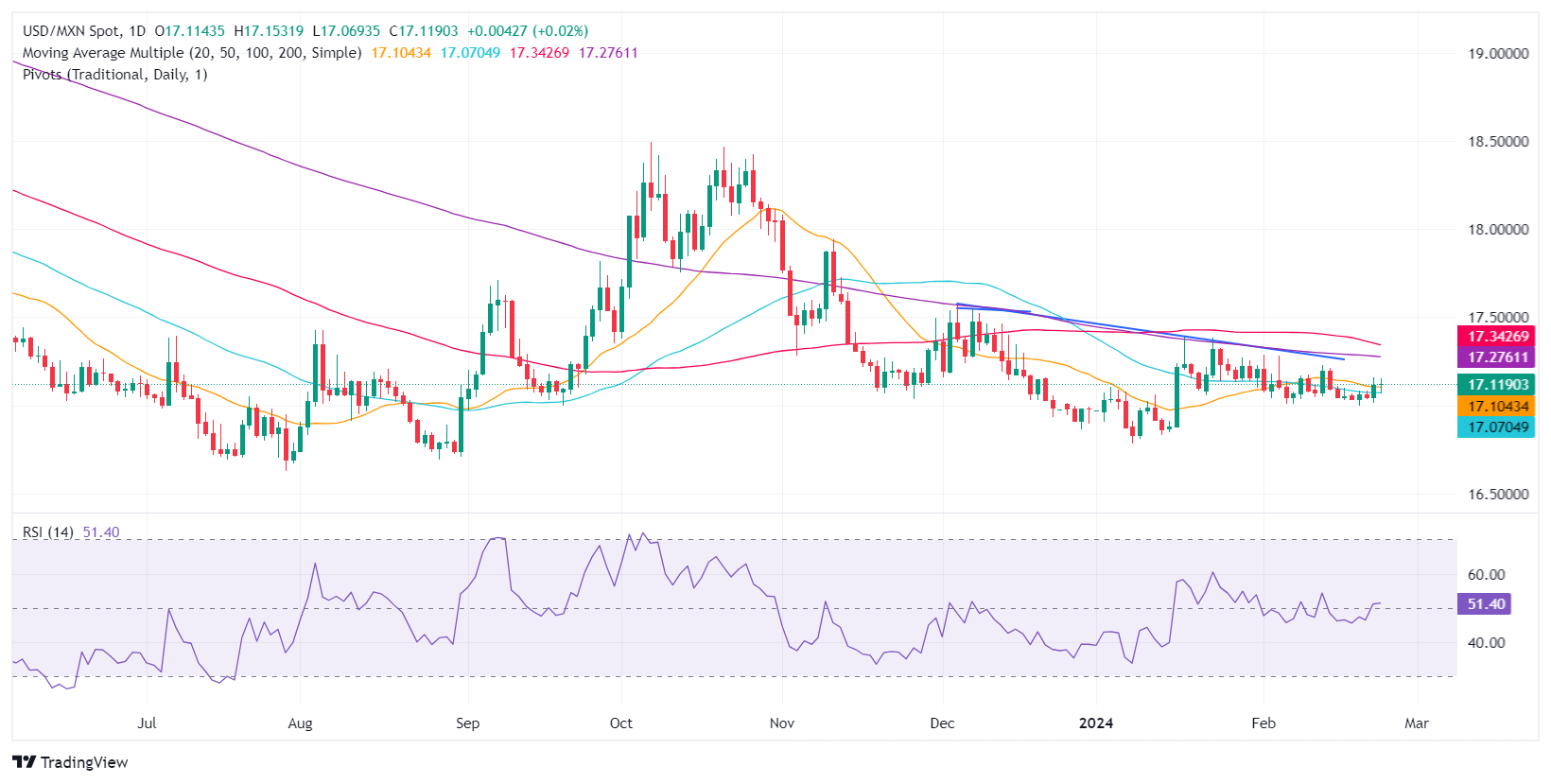Most recent article: Mexican Peso slips against US Dollar amid anticipation of key US, Mexican data
- Mexican Peso drops, reflecting concerns over Mexico's economic performance and potential Banxico rate cuts.
- Recent Mexican data shows inflation decline, GDP slowdown and significant drop in Retail Sales.
- Banxico minutes hint at possible easing in March with a shift toward a less hawkish monetary policy stance.
Mexican Peso loses steam for the second straight day against the US Dollar as market sentiment has shifted negatively. The Mexican currency is headed to end the week with losses after economic data witnessed inflation edging lower, the Gross Domestic Product (GDP) decelerating, and Retail Sales plummeting. At the time of writing, the USD/MXN exchanges hands at 17.14, up 0.20%.
The economic docket across the Bravo River is empty. Economic data revealed from Mexico showed the impact of higher interest rates set by the Bank of Mexico (Banxico). Although inflation dipped sharply in the first 15 days of February, the GDP for Q4 came in as expected at 2.5% YoY, exceeding forecasts but 0.8% lower compared to Q3 2023. Additionally, Retail Sales plunged, signaling that consumers reduced their spending.
In the meantime, Banxico’s latest minutes showed that the Governing Council could cut rates at the March 21 meeting as expressed by three of the five voting members. Two members added they can’t disregard maintaining rates at current levels. One of those members added he/she requires that underlying inflation shows a downward trajectory before beginning the easing cycle.
The language of the minutes was less “hawkish,” indicating a more flexible approach, according to analysts cited by El Economista. Analysts at Goldman Sachs commented that the Banxico Governing Council is tilting toward easing monetary policy unless exogenous shocks impact the USD/MXN exchange rate.
The USD/MXN has resumed its uptrend above the 50-day Simple Moving Average (SMA) following the release of last Thursday’s inflationary figures, while the sudden shift in Banxico’s rhetoric keeps the pair afloat above the 17.10 area.
Across the border, the Minutes of the US Federal Reserve (Fed) meeting showed that policymakers remain hesitant to cut rates amidst fears of a second round of inflation. Recently, the US Bureau of Labor Statistics (BLS) revealed that unemployment claims rose below estimates, while business activity, despite moderating, expanded.
Daily digest market movers: Mexican Peso hits seven-day low despite trimming some losses
- Mexico’s Consumer Price Index (CPI) in the first half of February dipped from 4.9% YoY to 4.45%, while core CPI slowed from 4.78% to 4.63% in the yearly data.
- GDP expanded in the fourth quarter by 0.1% QoQ but was lower than Q3’s 1.1% expansion. Annually based, GDP exceeded estimates of 2.4% and hit 2.5%, less than Q3’s 2023 3.3%.
- Mexico’s Retail Sales dropped -0.9% MoM, below estimates of 0.2%. Yearly figures plummeted -0.2% vs. a 2.5% forecast.
- The Mexican currency could depreciate further if the Mexican government fails to resolve its steel and aluminum dispute with the United States. US Trade Representative Katherine Tai warned the US could reimpose tariffs on the commodities.
- With no major events on the US economic calendar, recent unemployment claims figures and robust S&P Global Flash PMIs have backed Federal Reserve officials' hawkish remarks. Policymakers have expressed willingness to adjust policy when necessary but remain cautious, indicating no urgency to act. This stance is supported by current economic data suggesting strength in the economy, which could potentially revive inflationary pressures.
- Market players are expecting the first rate cut by the Federal Reserve at the June monetary policy meeting as they have trimmed odds for March and May.
Technical analysis: Mexican Peso extends losses to two-straight days as USD/MXN stays above 50-day SMA
The USD/MXN remains consolidated despite breaking above the 50-day Simple Moving Average (SMA) at 17.07. If buyers like to regain control, they must lift the exotic pair above 17.20, so they can threaten the 200-day SMA at 17.27. Once cleared, the 100-day SMA at 17.38 would be up next, ahead of the 17.50 figure.
On the other hand, if sellers step in and cap USD/MXN’s upside, they need to push prices below the 17.00 figure. Once cleared, the next support would be the current year-to-date (YTD) low of 16.78, followed by the 2023 low of 16.62.
USD/MXN Price Action – Daily Chart
Mexican Peso FAQs
What key factors drive the Mexican Peso?
The Mexican Peso (MXN) is the most traded currency among its Latin American peers. Its value is broadly determined by the performance of the Mexican economy, the country’s central bank’s policy, the amount of foreign investment in the country and even the levels of remittances sent by Mexicans who live abroad, particularly in the United States. Geopolitical trends can also move MXN: for example, the process of nearshoring – or the decision by some firms to relocate manufacturing capacity and supply chains closer to their home countries – is also seen as a catalyst for the Mexican currency as the country is considered a key manufacturing hub in the American continent. Another catalyst for MXN is Oil prices as Mexico is a key exporter of the commodity.
How do decisions of the Banxico impact the Mexican Peso?
The main objective of Mexico’s central bank, also known as Banxico, is to maintain inflation at low and stable levels (at or close to its target of 3%, the midpoint in a tolerance band of between 2% and 4%). To this end, the bank sets an appropriate level of interest rates. When inflation is too high, Banxico will attempt to tame it by raising interest rates, making it more expensive for households and businesses to borrow money, thus cooling demand and the overall economy. Higher interest rates are generally positive for the Mexican Peso (MXN) as they lead to higher yields, making the country a more attractive place for investors. On the contrary, lower interest rates tend to weaken MXN.
How does economic data influence the value of the Mexican Peso?
Macroeconomic data releases are key to assess the state of the economy and can have an impact on the Mexican Peso (MXN) valuation. A strong Mexican economy, based on high economic growth, low unemployment and high confidence is good for MXN. Not only does it attract more foreign investment but it may encourage the Bank of Mexico (Banxico) to increase interest rates, particularly if this strength comes together with elevated inflation. However, if economic data is weak, MXN is likely to depreciate.
How does broader risk sentiment impact the Mexican Peso?
As an emerging-market currency, the Mexican Peso (MXN) tends to strive during risk-on periods, or when investors perceive that broader market risks are low and thus are eager to engage with investments that carry a higher risk. Conversely, MXN tends to weaken at times of market turbulence or economic uncertainty as investors tend to sell higher-risk assets and flee to the more-stable safe havens.
Information on these pages contains forward-looking statements that involve risks and uncertainties. Markets and instruments profiled on this page are for informational purposes only and should not in any way come across as a recommendation to buy or sell in these assets. You should do your own thorough research before making any investment decisions. FXStreet does not in any way guarantee that this information is free from mistakes, errors, or material misstatements. It also does not guarantee that this information is of a timely nature. Investing in Open Markets involves a great deal of risk, including the loss of all or a portion of your investment, as well as emotional distress. All risks, losses and costs associated with investing, including total loss of principal, are your responsibility. The views and opinions expressed in this article are those of the authors and do not necessarily reflect the official policy or position of FXStreet nor its advertisers. The author will not be held responsible for information that is found at the end of links posted on this page.
If not otherwise explicitly mentioned in the body of the article, at the time of writing, the author has no position in any stock mentioned in this article and no business relationship with any company mentioned. The author has not received compensation for writing this article, other than from FXStreet.
FXStreet and the author do not provide personalized recommendations. The author makes no representations as to the accuracy, completeness, or suitability of this information. FXStreet and the author will not be liable for any errors, omissions or any losses, injuries or damages arising from this information and its display or use. Errors and omissions excepted.
The author and FXStreet are not registered investment advisors and nothing in this article is intended to be investment advice.
Recommended content
Editors’ Picks

GBP/USD holds gains near 1.2700 after UK inflation data
GBP/USD holds the latest uptick near 1.2700 in the European session on Wednesday. The data from the UK showed that the annual inflation, as measured by the change in the CPI, rose to 2.3% in October from 1.7% in September, supporting Pound Sterling.

EUR/USD stays pressured below 1.0600, ECB/ Fedspeak eyed
EUR/USD remains depressed below 1.0600 in European trading on Wednesday. The US Dollar advances, tracking US Treasury bond yields higher even though risk appetite returns on fading Russia-Ukraine geopolitical tensions. Central banks' speeches are eyed for fresh impetus.

Gold price moves away from one-week top on rising US bond yields, modest USD strength
Gold price retreats after touching a one-and-half-week top earlier this Wednesday and drops to a fresh daily low, below the $2,630 level heading into the European session. A goodish pickup in the US Treasury bond yields, bolstered by bets for a less aggressive policy easing by the Fed, revives the USD demand and undermines demand for the non-yielding yellow metal.

Why is Bitcoin performing better than Ethereum? ETH lags as BTC smashes new all-time high records
Bitcoin has outperformed Ethereum in the past two years, setting new highs while the top altcoin struggles to catch up with speed. Several experts exclusively revealed to FXStreet that Ethereum needs global recognition, a stronger narrative and increased on-chain activity for the tide to shift in its favor.

How could Trump’s Treasury Secretary selection influence Bitcoin?
Bitcoin remained upbeat above $91,000 on Tuesday, with Trump’s cabinet appointments in focus and after MicroStrategy purchases being more tokens.

Best Forex Brokers with Low Spreads
VERIFIED Low spreads are crucial for reducing trading costs. Explore top Forex brokers offering competitive spreads and high leverage. Compare options for EUR/USD, GBP/USD, USD/JPY, and Gold.
